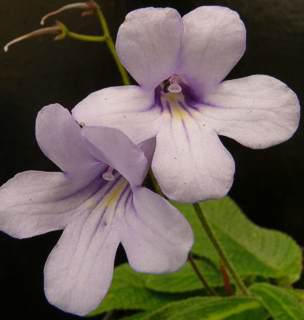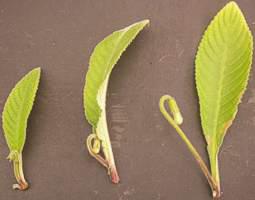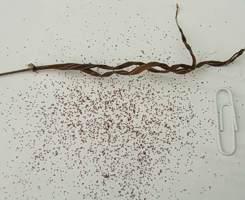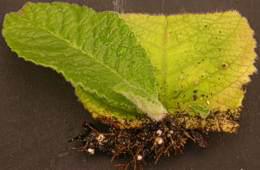Streptocarpus modestus
Streptocarpus modestus L.L.Britten
Family: Gesneriaceae
Common names: Pondo cliff streptocarpus, Cape primrose
Introduction
Streptocarpus modestus , with its lovely pale mauve flowers, makes a most rewarding pot plant, and is still quite unusual to have in the home today.

Description
Description
Streptocarpus modestus is a perennial shade-loving plant, fast-growing and so rewarding in the house or the garden.
An unusual feature of this soft herbaceous plant is that there are no stems; each leaf is actually an individual plant with its own roots and flowering stems.

Numerous slightly hairy light green leaves grow in a rosulate formation on a slender horizontal rootstock.
One to two flowers, but sometimes up to five, each with five broad, uneven petals are borne, each on a long slender flowering stem, throughout summer. Flowers are pale mauve with a white patch on the inside base of the flower, often striped with yellow, and also with striking violet stripes running along the lower petal into the flower tube. The flower petals and buds are covered with light short hairs. The long velvety fruit capsules will twist open in a spiral when dry, releasing a large amount of very small, light seeds.

Conservation Status
Status
Many of the Streptocarpus species are very specific in their distribution and occur in very small populations, making them vulnerable to any disturbance. Streptocarpus modestus is listed as rare in the current national Red Data List.
Distribution and habitat
Distribution description
This Streptocarpus occurs only in a limited area of Pondoland in the Eastern Cape where it grows rooted in soil as well as wedged in cliff crevices. It is found in quite dry, shaded habitats.
Derivation of name and historical aspects
History
The name Streptocarpus is derived from the Greek words streptos meaning twisted and carpus meaning fruit, which is a perfect description of the plant's spirally twisted seed pods.
Streptocarpus belongs to the same family, Gesneriaceae, as the well-known African violets and gloxinias that are grown as pot plants all over the world. Gesneriaceae — named in 1963 after Konrad Gesner, a Swiss scholar, thirty years after his death — is a large family of mostly tropical and subtropical herbs, with ± 130 genera, and ± 2900 species worldwide.
Streptocarpus, comprised of ± 51 species and native to southern Africa, is one of eight genera of this family occurring in Africa.
Ecology
Ecology
Gesneriaceae are often epiphytic (growing on trees) or lithophytic (growing on rocks). The plants can cross-pollinate easily with other species but in many instances are self-pollinated. The very small seed is wind-distributed.
Uses
Use
Some species of Streptocarpus are used in Zulu medicine where leaf infusions are drunk to ease birthing pains.
Growing Streptocarpus modestus
Grow
It does best as a pot plant rather than planted out in the garden. Ensure a warm spot with good light but no direct sunlight. The plant in general is very sensitive to light, is burned easily by the sun and flowers poorly in deep shade. Light shade with good ventilation is best for growing healthy plants with plenty of flowers.
Watering Streptocarpus should be done with care. It is very important that the plants should not be over-watered, to prevent rotting and fungal problems occur. Allow them to get quite dry between watering. They can be allowed to wilt slightly as they have the ability to recover very well from this, but be aware that severe wilting can be a sign of root rot caused by over-watering, so check the medium to see that this is not the case. During the warm summers when they are actively growing, they need plenty of water. Most of the Streptocarpus species are dormant during winter and need very little water during this stage.
Regularly remove all dead unhealthy and dying leaves and flowers as these encourage fungal growth, and to keep the plants looking attractive. The tips of the leaves often die off as they get older and when stressed by drought or low temperature or when overwintering. This survival tactic does not harm the plants; although the dead ends may look unattractive, each of the leaves simply forms an abscission layer and continues with new growth from the base. Regular feeding during the growing season with liquid foliar feed is recommended.
All propagation is best done in spring which is the start of the growing season. Streptocarpus modestus can easily be grown from seed. When sowing the seeds, mix a pinch of the dust-like seeds with a small amount of sand to assist with spreading the seeds evenly. Use a well-drained medium that is not too coarse. Cover with a very thin covering of sand, keep out of direct sun but in warmth. Water regularly with a fine spray. Germination usually takes 3 to 4 weeks. Do not allow the seedlings to dry out. Plant them into small pots only once they are quite big and strong. Transplant again into bigger pots when the roots have filled the small pots.
Streptocarpus can be propagated from a single leaf and the best results are from leaf cuttings taken in spring and early summer. A variety of mediums can be used as long as they are well-drained. Sand, bark, palm fibre and polystyrene or vermiculite in different ratios are all suitable. At Kirstenbosch we use 40% bark, 40% polystyrene and 20% sand. Water the medium well and treat with a suitable fungicide before using. Select healthy youngish leaves from the centre of the plant and cut off using a sharp knife or blade. Remember that the most active region of the leaf is near the base where the growing region (meristem) is present and so this area will yield the best rooting results. If it is a small leaf, insert the cut end of the leaf into a rooting hormone and then into the medium. Larger leaves can be cut into 3 cm strips.

Always take note of which way the leaf cutting should be orientated before dipping into a rooting hormone and place firmly into the medium but not too deep, as this will encourage rot. Alternatively, cut along either side of the midrib and treat in the same manner. Depending on the species, plantlets will form along the base of the cut in one to three months.
When the plantlets are well established, the old leaf can be teased out from the medium and the plantlets potted up, usually between 6-12 months. Plants that have grown quite large can also be divided as a method of increasing them; do this in early spring and repot to grow on. Mature plants can lose their vigour after 3 to 5 years and propagation as described above can be used to replace them with younger plants.
Mealybug and caterpillars are the most troublesome pests of Streptocarpus. Caterpillars can either be hand collected or sprayed with a suitable poison; if mealybug is found on any part of the plant, remove the affected parts and treat with a suitable pesticide.
Fungal infections are also a cause for concern; if fungus is found on any part of the plant, remove the affected parts and treat with a suitable fungicide.
References
- Batten, A. 1986. Flowers of southern Africa. Frandson Publishers, Sandton.
- Burtt, B.L. & Hilliard, O.M. 1971. Streptocarpus, an African plant study. University of Natal Press, Pietermaritzburg.
- Hutchings, A. 1996. Zulu medicinal plants: An inventory. University of Natal Press, Pietermaritzburg.
- Leistner, O.A. (ed.). 2000. Seeds plants of southern Africa: families and genera. Strelitzia 10. National Botanical Institute, Pretoria.
- Pooley, E. 1998. A field guide to wild flowers of KwaZulu-Natal and the Eastern Region. Natal Flora Publications Trust, Durban.
Credits
Cherise Viljoen
Kirstenbosch National Botanical Garden
April 2009
Plant Attributes:
Plant Type: Perennial
SA Distribution: Eastern Cape
Soil type: Loam
Flowering season: Spring, Early Summer, Late Summer, Autumn
PH: Neutral
Flower colour: White, Mauve/Lilac
Aspect: Shade
Gardening skill: Challenging
Special Features:
Horticultural zones








Rate this article
Article well written and informative
Rate this plant
Is this an interesting plant?
Login to add your Comment
Back to topNot registered yet? Click here to register.